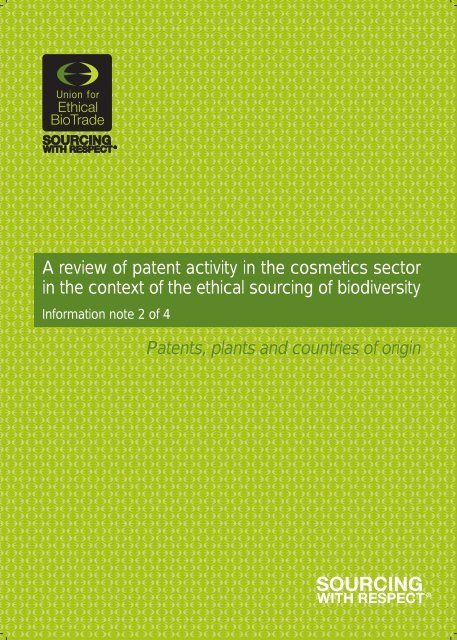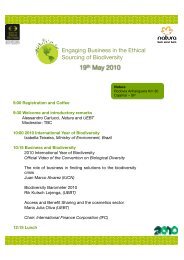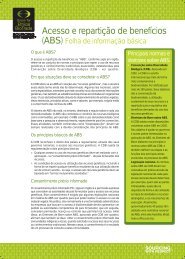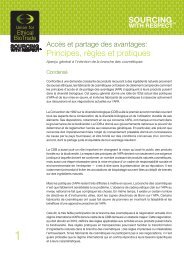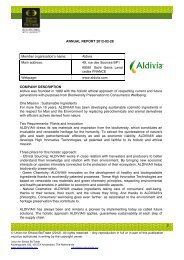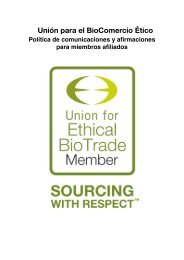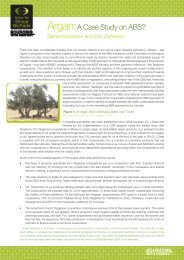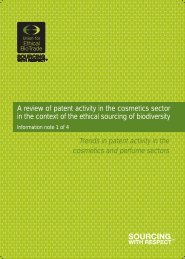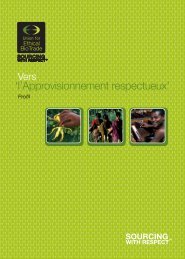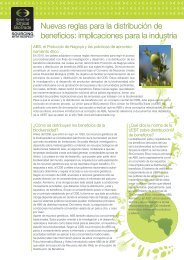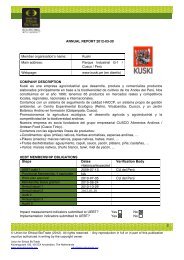A review of patent activity in the cosmetics - the Union for Ethical ...
A review of patent activity in the cosmetics - the Union for Ethical ...
A review of patent activity in the cosmetics - the Union for Ethical ...
You also want an ePaper? Increase the reach of your titles
YUMPU automatically turns print PDFs into web optimized ePapers that Google loves.
A <strong>review</strong> <strong>of</strong> <strong>patent</strong> <strong>activity</strong> <strong>in</strong> <strong>the</strong> <strong>cosmetics</strong> sector<br />
<strong>in</strong> <strong>the</strong> context <strong>of</strong> <strong>the</strong> ethical sourc<strong>in</strong>g <strong>of</strong> biodiversity<br />
In<strong>for</strong>mation note 2 <strong>of</strong> 4<br />
Patents, plants and countries <strong>of</strong> orig<strong>in</strong>
Introduction<br />
Natural products are ga<strong>in</strong><strong>in</strong>g considerable ground <strong>in</strong> <strong>cosmetics</strong> and perfumes and a major proportion <strong>of</strong> <strong>patent</strong> <strong>activity</strong><br />
<strong>in</strong> <strong>the</strong>se sectors <strong>in</strong>volves <strong>in</strong>gredients and extracts <strong>of</strong> natural orig<strong>in</strong> (see In<strong>for</strong>mation Note 1 <strong>in</strong> this series, which focuses<br />
on trends <strong>in</strong> <strong>patent</strong> <strong>activity</strong> <strong>in</strong> <strong>the</strong> <strong>cosmetics</strong> and perfume sectors). But what plants are <strong>in</strong>volved <strong>in</strong> <strong>patent</strong> <strong>activity</strong>? Where<br />
do <strong>the</strong>se plants come from? The answer to <strong>the</strong>se questions is significant to determ<strong>in</strong>e <strong>the</strong> potential impact <strong>of</strong> <strong>the</strong>se<br />
<strong>patent</strong>s on ef<strong>for</strong>ts towards <strong>the</strong> susta<strong>in</strong>able use <strong>of</strong> biodiversity and <strong>the</strong> equitable shar<strong>in</strong>g <strong>of</strong> result<strong>in</strong>g benefits. It is also<br />
critical <strong>in</strong> light <strong>of</strong> emerg<strong>in</strong>g requirements to disclose <strong>the</strong> country <strong>of</strong> orig<strong>in</strong> <strong>of</strong> genetic resources and traditional knowledge<br />
as a way to monitor compliance with access and benefit shar<strong>in</strong>g obligations.<br />
This In<strong>for</strong>mation Note on “Patents, plants and countries <strong>of</strong> orig<strong>in</strong>” is <strong>the</strong> second <strong>in</strong> a series <strong>review</strong><strong>in</strong>g <strong>patent</strong> <strong>activity</strong> <strong>in</strong><br />
<strong>the</strong> <strong>cosmetics</strong> sector <strong>in</strong> <strong>the</strong> context <strong>of</strong> <strong>the</strong> requirements <strong>of</strong> <strong>the</strong> ethical sourc<strong>in</strong>g <strong>of</strong> biodiversity and <strong>the</strong> Convention on<br />
Biological Diversity (CBD), and provides data and analysis on <strong>the</strong> follow<strong>in</strong>g issues:<br />
• Top plant families, genera and species <strong>in</strong> <strong>patent</strong> documents <strong>for</strong> <strong>in</strong>gredients and extracts <strong>in</strong> <strong>the</strong> <strong>cosmetics</strong> and<br />
perfumes sectors<br />
• Distribution <strong>of</strong> <strong>the</strong>se species, particularly <strong>in</strong> relation to countries outside North America and Europe, and<br />
• Exist<strong>in</strong>g references to country names, <strong>in</strong>clud<strong>in</strong>g <strong>in</strong> relation to <strong>the</strong> orig<strong>in</strong> <strong>of</strong> <strong>the</strong> species, <strong>in</strong> <strong>the</strong>se <strong>patent</strong> documents.<br />
A <strong>review</strong> <strong>of</strong> <strong>patent</strong> <strong>activity</strong> <strong>in</strong> <strong>the</strong> <strong>cosmetics</strong> sector<br />
Biodiversity is recognized as a source <strong>of</strong> <strong>in</strong>novation <strong>in</strong> <strong>the</strong> <strong>cosmetics</strong> sector. Yet how is it addressed <strong>in</strong> <strong>the</strong> context<br />
<strong>of</strong> <strong>in</strong>creas<strong>in</strong>gly active <strong>patent</strong><strong>in</strong>g strategies? Look<strong>in</strong>g at how companies seek and exploit <strong>in</strong>tellectual property<br />
protection <strong>in</strong> relation to natural <strong>in</strong>gredients is important <strong>in</strong> light <strong>of</strong> <strong>the</strong> complex and <strong>of</strong>ten controversial relationship<br />
between <strong>patent</strong>s and biodiversity.<br />
Legal and policy measures are currently be<strong>in</strong>g considered at <strong>the</strong> <strong>in</strong>ternational, regional and national levels to<br />
address <strong>the</strong>se concerns. A grow<strong>in</strong>g number <strong>of</strong> companies engaged with <strong>the</strong> ethical sourc<strong>in</strong>g <strong>of</strong> biodiversity are<br />
also seek<strong>in</strong>g guidance on <strong>the</strong> design and implementation <strong>of</strong> <strong>patent</strong> and biodiversity policies that will recognize<br />
and advance <strong>the</strong> objectives <strong>of</strong> <strong>the</strong> Convention on Biological Diversity (CBD).<br />
To contribute to ef<strong>for</strong>ts towards a more mutually supportive relationship between <strong>patent</strong>s and biodiversity, <strong>the</strong><br />
<strong>Union</strong> <strong>for</strong> <strong>Ethical</strong> BioTrade (UEBT) commissioned an analysis <strong>of</strong> <strong>the</strong> <strong>patent</strong> landscape <strong>for</strong> natural <strong>in</strong>gredients <strong>in</strong><br />
<strong>the</strong> <strong>cosmetics</strong> sector, as well as study <strong>of</strong> <strong>the</strong> types and orig<strong>in</strong>s <strong>of</strong> plants referenced <strong>in</strong> <strong>the</strong>se <strong>patent</strong> publications<br />
and <strong>the</strong> types <strong>of</strong> claims be<strong>in</strong>g sought and granted. Research was conducted by Dr. Paul Oldham, Research<br />
Fellow at <strong>the</strong> ESRC Centre <strong>for</strong> Economic and Social Aspects <strong>of</strong> Genomics at Lancaster University and renowned<br />
expert on <strong>patent</strong>s and biodiversity. The In<strong>for</strong>mation Notes <strong>in</strong> this series provide a summary <strong>of</strong> <strong>the</strong> data and ma<strong>in</strong><br />
f<strong>in</strong>d<strong>in</strong>gs <strong>in</strong> <strong>the</strong> research conducted by Dr. Oldham on behalf <strong>of</strong> UEBT.<br />
Plants and <strong>patent</strong>s <strong>in</strong> <strong>the</strong> <strong>cosmetics</strong> sector<br />
In order to f<strong>in</strong>d <strong>the</strong> specific biodiversity implicated <strong>in</strong> <strong>patent</strong> <strong>activity</strong> <strong>in</strong> <strong>the</strong> <strong>cosmetics</strong> and perfumes sector, a search<br />
<strong>for</strong> species names taken from <strong>the</strong> Species 2000 & ITIS Catalogue <strong>of</strong> Life was conducted with<strong>in</strong> <strong>the</strong> series <strong>of</strong> <strong>patent</strong><br />
documents identified <strong>for</strong> <strong>in</strong>gredients and extracts (see In<strong>for</strong>mation Note 1 <strong>in</strong> this series) i . This search found a total <strong>of</strong><br />
2,101 full species names, belong<strong>in</strong>g to 944 genera and 388 families <strong>in</strong> <strong>the</strong> titles, abstracts and claims <strong>of</strong> 3,523 <strong>patent</strong><br />
documents. As shown by Table 1, most <strong>of</strong> <strong>the</strong>se are from <strong>the</strong> plant k<strong>in</strong>gdom.<br />
Table 1: Number <strong>of</strong> species by k<strong>in</strong>gdom<br />
Catalogue or Life Number <strong>of</strong> Species<br />
Plantae 1289<br />
Bacteria 385<br />
Fungi 302<br />
Animalia 59<br />
Chromista 41<br />
Arthropoda 14<br />
Viruses 7<br />
Protozoa 2<br />
Archaea 1<br />
Patents, plants and<br />
countries <strong>of</strong> orig<strong>in</strong><br />
In<strong>for</strong>mation Note 2<br />
It is important to note that <strong>patent</strong> documents may conta<strong>in</strong> references to<br />
species <strong>for</strong> a range <strong>of</strong> reasons. References may <strong>in</strong>clude species caus<strong>in</strong>g<br />
conditions (<strong>for</strong> example, acne caused by Propionibacterium acnes) or as<br />
media <strong>for</strong> use <strong>in</strong> biotechnology and fermentation (<strong>for</strong> example, E. coli or<br />
S. cerevisiae). Patent applicants may also make reference to <strong>the</strong> species<br />
to which a claimed <strong>in</strong>vention will apply – quite commonly, terms such as<br />
mammals or mammalian are used to maximise <strong>the</strong> scope <strong>of</strong> claims.<br />
Species may also co-occur as multiple <strong>in</strong>gredients <strong>in</strong> a cosmetic<br />
composition. As a result, <strong>patent</strong> documents <strong>of</strong>ten conta<strong>in</strong> multiple<br />
references to species. For example, <strong>the</strong> species Aloe vera co-occurs with<br />
over 100 species, from various k<strong>in</strong>gdoms <strong>in</strong> <strong>patent</strong> documents.<br />
1
Patents, plants and<br />
countries <strong>of</strong> orig<strong>in</strong><br />
In<strong>for</strong>mation Note 2<br />
Focus<strong>in</strong>g on plants, <strong>the</strong> search identified a total <strong>of</strong> 1,289 full species names, belong<strong>in</strong>g to 182 families and 632 genera.<br />
Table 2 sets out <strong>the</strong> top plant families with<strong>in</strong> <strong>the</strong> records. Table 3 moves down one level to group <strong>the</strong> results by <strong>the</strong> top<br />
genera. Table 4 lists <strong>the</strong> top species <strong>in</strong>volved <strong>in</strong> <strong>patent</strong> <strong>activity</strong>. Aloe vera, a species <strong>of</strong> succulent plant whose leaves<br />
conta<strong>in</strong> a range <strong>of</strong> biologically active compounds and have been long used <strong>in</strong> herbal medic<strong>in</strong>e, leads <strong>the</strong> number <strong>of</strong><br />
references <strong>in</strong> <strong>patent</strong> records. Centella asiatica and G<strong>in</strong>gko biloba, both used primarily <strong>for</strong> sk<strong>in</strong> care products, also appear<br />
<strong>in</strong> a high number <strong>of</strong> <strong>patent</strong> records.<br />
Table 2: Top plant families<br />
(Count <strong>of</strong> species)<br />
Rank Families Count <strong>of</strong> Species<br />
1 Rosaceae 231<br />
2 Fabaceae 228<br />
3 Rubiaceae 114<br />
4 Not assigned 94<br />
5 Asteraceae 58<br />
6 Oleaceae 47<br />
7 Lamiaceae 38<br />
8 Arecaceae 25<br />
9 Poaceae 25<br />
10 Z<strong>in</strong>giberaceae 23<br />
The orig<strong>in</strong> <strong>of</strong> plant species<br />
Table 3: Top plant genera<br />
(Count <strong>of</strong> species)<br />
Rank Families Count <strong>of</strong> Species<br />
1 C<strong>of</strong>fea 101<br />
2 Rosa 92<br />
3 Prunus 35<br />
4 Rubus 28<br />
5 Bauh<strong>in</strong>ia 19<br />
6 Smilax 16<br />
7 Frax<strong>in</strong>us 16<br />
8 Acacia 16<br />
9 Pyrus 15<br />
10 Vacc<strong>in</strong>ium 13<br />
Table 4: Top plant species (Number <strong>of</strong> <strong>patent</strong> records)<br />
Patent<br />
Rank Plant species Records<br />
1 Aloe vera 386<br />
2 Centella asiatica 141<br />
3 G<strong>in</strong>gko biloba 92<br />
4 Glycyrrhiza glabra 61<br />
5 Vitis v<strong>in</strong>ifera 61<br />
6 Camellia s<strong>in</strong>ensis 59<br />
7 Persea americana 51<br />
8 V<strong>in</strong>ca m<strong>in</strong>or 49<br />
9 Prunus persica 48<br />
10 Rosmar<strong>in</strong>us <strong>of</strong>fic<strong>in</strong>alis 46<br />
11 Rhus vernicifera 45<br />
12 Serenoa repens 38<br />
Patent<br />
Rank Plant species Records<br />
13 Curcuma longa 35<br />
14 Salivia <strong>of</strong>fic<strong>in</strong>alis 31<br />
15 Emblica <strong>of</strong>fic<strong>in</strong>alis 28<br />
16 Azadirachta <strong>in</strong>dica 27<br />
17 Citrus aurantium 23<br />
18 Juglans regia 23<br />
19 Panax g<strong>in</strong>seng 23<br />
20 Chondrus crispus 22<br />
21 Hypericum per<strong>for</strong>atum 22<br />
22 Morus alba 21<br />
23 Sorghym caudatum 21<br />
24 Vacc<strong>in</strong>ium myrtillus 21<br />
A central question <strong>in</strong> discussions on access to genetic resources and benefit shar<strong>in</strong>g is <strong>the</strong> country <strong>of</strong> orig<strong>in</strong> <strong>of</strong> <strong>the</strong>se<br />
resources. The CBD recognizes <strong>the</strong> sovereign rights <strong>of</strong> States over <strong>the</strong>ir natural resources, and <strong>the</strong>ir authority to<br />
determ<strong>in</strong>e whe<strong>the</strong>r and how access to genetic resources is permitted. Determ<strong>in</strong><strong>in</strong>g <strong>the</strong> country <strong>of</strong> orig<strong>in</strong> <strong>of</strong> <strong>the</strong> genetic<br />
resources or associated traditional knowledge used <strong>in</strong> products or processes is thus fundamental to monitor<strong>in</strong>g such<br />
use <strong>of</strong> biodiversity, as well as to ensur<strong>in</strong>g compliance with any requirements <strong>of</strong> prior <strong>in</strong><strong>for</strong>med consent and equitable<br />
shar<strong>in</strong>g <strong>of</strong> benefits established by <strong>the</strong> relevant national legislation. Indeed, negotiations are currently underway <strong>in</strong> a<br />
range <strong>of</strong> <strong>in</strong>ternational <strong>for</strong>a on norms requir<strong>in</strong>g disclosure <strong>of</strong> orig<strong>in</strong> <strong>in</strong> <strong>patent</strong> applications. In this context, it is useful to<br />
analyze whe<strong>the</strong>r and how <strong>the</strong> orig<strong>in</strong> <strong>of</strong> plants is already mentioned <strong>in</strong> <strong>patent</strong> documents.<br />
To determ<strong>in</strong>e current practices on referenc<strong>in</strong>g <strong>the</strong> orig<strong>in</strong> <strong>of</strong> resources <strong>in</strong> <strong>patent</strong> documents <strong>in</strong> <strong>the</strong> <strong>cosmetics</strong> and perfumes<br />
sector, <strong>the</strong> complete text <strong>of</strong> <strong>patent</strong> documents identified as conta<strong>in</strong><strong>in</strong>g species distributed outside Europe and North<br />
America were processed <strong>for</strong> references to country names ii . The focus on species orig<strong>in</strong>at<strong>in</strong>g outside <strong>of</strong> <strong>the</strong>se<br />
2
Patents, plants and<br />
countries <strong>of</strong> orig<strong>in</strong><br />
In<strong>for</strong>mation Note 2<br />
countries responds to <strong>the</strong> dynamics <strong>of</strong> <strong>the</strong> debate on access and benefit shar<strong>in</strong>g, which is characterized by considerations<br />
l<strong>in</strong>ked to <strong>the</strong> need to address biodiversity <strong>in</strong> <strong>the</strong> context <strong>of</strong> susta<strong>in</strong>able development strategies. In total, 378 raw<br />
references to country names were found <strong>in</strong> <strong>the</strong> sample <strong>of</strong> 3,252 documents, <strong>of</strong> which 166 were directly associated<br />
with species names. A sample <strong>of</strong> <strong>the</strong> result<strong>in</strong>g data is presented as a concordance table – an <strong>in</strong>dex <strong>of</strong> selected country<br />
names, show<strong>in</strong>g <strong>the</strong>ir location <strong>in</strong> <strong>the</strong> text <strong>of</strong> <strong>the</strong> <strong>patent</strong> documents conta<strong>in</strong><strong>in</strong>g species– <strong>in</strong> Figure 1.<br />
Figure 1: Country names <strong>in</strong> <strong>patent</strong> documents<br />
As is clear from Figure 1, references to country names may be found with<strong>in</strong> <strong>the</strong> whole text <strong>of</strong> documents <strong>for</strong> a<br />
range <strong>of</strong> reasons. These country names may be <strong>in</strong> <strong>the</strong> context <strong>of</strong> literature references, <strong>the</strong> location <strong>of</strong> a company,<br />
<strong>the</strong> name <strong>of</strong> a species (<strong>for</strong> example, A. senegal) or to <strong>the</strong> use given to particular plants <strong>in</strong> particular countries (<strong>for</strong><br />
example, <strong>the</strong> use <strong>of</strong> T<strong>in</strong>ea species to treat r<strong>in</strong>gworm <strong>in</strong> children <strong>in</strong> Kenya). Figure 1 also reveals that disclosure <strong>of</strong><br />
orig<strong>in</strong> may refer to <strong>the</strong> entire distribution <strong>of</strong> <strong>the</strong> species across multiple countries.<br />
A similar search was conducted with<strong>in</strong> <strong>the</strong>se <strong>patent</strong> documents <strong>for</strong> references to country names and terms l<strong>in</strong>ked<br />
to traditional knowledge. The orig<strong>in</strong> <strong>of</strong> traditional knowledge is equally relevant <strong>in</strong> <strong>the</strong> context <strong>of</strong> ensur<strong>in</strong>g compliance<br />
with CBD pr<strong>in</strong>ciples <strong>of</strong> prior <strong>in</strong><strong>for</strong>med consent and equitable shar<strong>in</strong>g <strong>of</strong> benefits. A total <strong>of</strong> 250 raw results were<br />
returned on a limited set <strong>of</strong> experimental search terms, <strong>in</strong>clud<strong>in</strong>g “traditional medic<strong>in</strong>e,” “traditionally,” “natives,”<br />
“native people,” “<strong>in</strong>digenous peoples.” Figure 2, however, demonstrates that <strong>the</strong>se references are generally not<br />
l<strong>in</strong>ked to disclosure <strong>of</strong> orig<strong>in</strong>, but ra<strong>the</strong>r to literature citations <strong>of</strong> prior art, descriptions <strong>of</strong> known uses <strong>of</strong> particular<br />
plant materials, or use <strong>of</strong> <strong>the</strong> term native to describe compounds. As a result, <strong>the</strong> available data suggests that<br />
disclosure <strong>of</strong> <strong>the</strong> country <strong>of</strong> orig<strong>in</strong> <strong>of</strong> biological materials and associated traditional knowledge is presently low.<br />
3
Figure 2: Traditional knowledge-related terms <strong>in</strong> <strong>patent</strong> documents<br />
Patents, plants and<br />
countries <strong>of</strong> orig<strong>in</strong><br />
In<strong>for</strong>mation Note 2<br />
Yet complet<strong>in</strong>g <strong>the</strong> <strong>in</strong><strong>for</strong>mation on <strong>the</strong> orig<strong>in</strong> <strong>of</strong> plant species referenced <strong>in</strong> <strong>patent</strong> documents is not simple. There are<br />
challenges <strong>in</strong> <strong>the</strong> availability <strong>of</strong> distribution data with<strong>in</strong> taxonomic records, as well as <strong>in</strong> <strong>the</strong> accuracy <strong>of</strong> such <strong>in</strong><strong>for</strong>mation.<br />
Indeed, <strong>in</strong> <strong>the</strong> Catalogue <strong>of</strong> Life, distribution data was available <strong>for</strong> only 43% <strong>of</strong> <strong>the</strong> species identified <strong>in</strong> <strong>the</strong> <strong>patent</strong>s.<br />
Fur<strong>the</strong>rmore, some species may be classified <strong>in</strong> terms <strong>of</strong> <strong>the</strong>ir orig<strong>in</strong>s but <strong>in</strong> reality be cultivated elsewhere. Moreover,<br />
distribution data may refer to a country, a place or a region, and references to countries are not uni<strong>for</strong>m.<br />
For species referenced <strong>in</strong> <strong>the</strong> <strong>patent</strong> documents perta<strong>in</strong><strong>in</strong>g to <strong>in</strong>gredients <strong>in</strong> <strong>the</strong> <strong>cosmetics</strong> and perfumes sectors,<br />
ef<strong>for</strong>ts were made to determ<strong>in</strong>e regional distribution, as shown <strong>in</strong> Table 5. In this table, <strong>the</strong> figures <strong>in</strong> bold correspond<br />
to <strong>the</strong> total number <strong>of</strong> records <strong>for</strong> a particular region, with <strong>the</strong> rema<strong>in</strong><strong>in</strong>g numbers show<strong>in</strong>g records <strong>for</strong> plant species<br />
that also occur <strong>in</strong> o<strong>the</strong>r regions iii . This data demonstrates that plants frequently co-occur <strong>in</strong> various countries and<br />
regions, by virtue <strong>of</strong> natural distribution or because <strong>the</strong>y have been <strong>in</strong>troduced.<br />
Table 5: Plant species by regional distribution<br />
Distribution North Central Asia Africa Oceania Europe South Middle<br />
America America America East<br />
& Caribbean<br />
North America 426 113 4 2 89 3 2<br />
Central America & 113 181 12 6 66 6 1<br />
Caribbean<br />
Asia 4 12 175 35 22 32 6 7<br />
Africa 2 6 35 166 17 18 9 9<br />
Oceania 89 66 22 17 143 12 7 4<br />
Europe 3 32 18 12 60 3 9<br />
South America 6 6 9 7 3 35 1<br />
Middle East 2 1 7 9 4 9 1 13<br />
4
Patents, plants and<br />
countries <strong>of</strong> orig<strong>in</strong><br />
In<strong>for</strong>mation Note 2<br />
In particular, on <strong>the</strong> basis <strong>of</strong> available distribution data, a search was conducted <strong>for</strong> plant species <strong>in</strong>volved <strong>in</strong> <strong>patent</strong><br />
<strong>activity</strong> and distributed outside North America and Europe. Of <strong>the</strong> 1,289 species identified <strong>in</strong> <strong>the</strong> <strong>patent</strong> data, 806 plant<br />
species fell with<strong>in</strong> this category. Table 6 shows <strong>the</strong> top results <strong>in</strong> relation to <strong>the</strong> countries and areas <strong>of</strong> distribution <strong>for</strong><br />
<strong>the</strong>se species. Table 6 makes clear that <strong>patent</strong> <strong>activity</strong> <strong>for</strong> <strong>cosmetics</strong> and perfumes <strong>in</strong>volv<strong>in</strong>g species distributed outside<br />
Europe and North America is significant. Based on this list, <strong>the</strong> top <strong>patent</strong> assignees <strong>for</strong> Non-European or North American<br />
species is provided <strong>in</strong> Table 7.<br />
Table 6: Non-North American or European plant species by distribution (Number<br />
<strong>of</strong> species)<br />
Distribution No<br />
Madagascar 54<br />
Ch<strong>in</strong>a 38<br />
Caribbean 34<br />
India 23<br />
Bangladesh 21<br />
Oceania 19<br />
Australia 17<br />
Afghanistan 16<br />
Tanzania 15<br />
Brazil 15<br />
Bhutan 14<br />
Cameroon 13<br />
Distribution No<br />
Myanmar 13<br />
Japan 13<br />
Africa 12<br />
Indonesia 12<br />
Kenya 12<br />
Angola 11<br />
Mauritius 10<br />
Andaman Is 10<br />
Cambodia 9<br />
Nepal 9<br />
Vietnam 9<br />
Malaysia 8<br />
Patent Assignees Not Europe /<br />
North America<br />
L’OREAL SA 150<br />
COGNIS FRANCE SA 59<br />
LVMH RECH 53<br />
LVMH RECH GRP INTERET ECOMONIQUE 32<br />
LAB SEROBIOLOGIQUES SA 28<br />
AVON PROD INC 28<br />
PROCTER & GAMBLE CO 28<br />
COTY BV 27<br />
SHISEIDO CO LTD 26<br />
BEIERSDORF AG 25<br />
MERCK PATENT GMBH 23<br />
UNILEVER 22<br />
LANCASTER GROUP GMBH 20<br />
COTY PRESTIGE LANCASTER GROUP GMBH 19<br />
Distribution No<br />
Seychelles 7<br />
Algeria 7<br />
Ethiopia 7<br />
French Guiana 7<br />
Papau New Gu<strong>in</strong>ea 7<br />
S. Trop. America 7<br />
Taiwan 7<br />
Argent<strong>in</strong>a 7<br />
Laos 7<br />
Mexico 6<br />
Mexico to C. America 6<br />
Mozambique 6<br />
Table 7: Top Patent Assignees (Number <strong>of</strong> <strong>patent</strong> records)<br />
Distribution across multiple countries<br />
Distribution No<br />
Ghana 6<br />
Peru 6<br />
Philipp<strong>in</strong>es 6<br />
Sri Lanka 6<br />
Colombia 6<br />
Zaire 6<br />
Ha<strong>in</strong>an (Ch<strong>in</strong>a) 5<br />
South Africa 5<br />
Sur<strong>in</strong>am 5<br />
Thailand 5<br />
Ivory Coast 5<br />
Mauritania 4<br />
Patent Assignees Not Europe /<br />
North America<br />
NATREON INC 18<br />
HINDUSTAN LEVER LTD 18<br />
SEDERMA SA 18<br />
COSMEDERM INC 16<br />
COUNCIL SCI & IND RE INDIA 16<br />
UNILEVER HOME & PERSONAL CARE USA DIV CO 16<br />
KAO CORP 15<br />
COGNIS IP MANAGEMENT GMBH 15<br />
CIBA GEIGY AG 13<br />
HENKEL KGAA 13<br />
DANISCO AS 12<br />
MIKIMOTO SEIYAKU KK 12<br />
CLARINS 12<br />
SILAB SOC IND LIMOUSINE APPL BIOLOGIQUE 12<br />
Ano<strong>the</strong>r conclusion that can be drawn from <strong>the</strong> analysis <strong>of</strong> <strong>the</strong> orig<strong>in</strong> <strong>of</strong> species referenced <strong>in</strong> <strong>the</strong> <strong>patent</strong> data is that<br />
<strong>patent</strong> <strong>activity</strong> will frequently affect multiple countries at <strong>the</strong> level <strong>of</strong> distribution <strong>of</strong> species. This is illustrated <strong>in</strong> Figure<br />
3, which presents an Aduna cluster map <strong>of</strong> <strong>the</strong> distribution <strong>of</strong> species with<strong>in</strong> <strong>in</strong>dividual regions. Yellow dots mark<br />
<strong>in</strong>dividual species and co-occurrence across regions is marked by l<strong>in</strong>ks from <strong>the</strong> species to o<strong>the</strong>r regions. As highlighted<br />
by Figure 3, species will, <strong>of</strong>ten, if not regularly, be distributed across multiple countries and regions. This issue is<br />
frequently underestimated <strong>in</strong> debates on <strong>the</strong> country <strong>of</strong> orig<strong>in</strong> <strong>of</strong> biodiversity <strong>for</strong> <strong>the</strong> purposes <strong>of</strong> compliance with access<br />
and benefit shar<strong>in</strong>g pr<strong>in</strong>ciples.<br />
5
Patents, plants and<br />
countries <strong>of</strong> orig<strong>in</strong><br />
In<strong>for</strong>mation Note 2<br />
Figure 3: Aduna cluster map <strong>of</strong> regional concentrations <strong>of</strong> species and cooccurrence<br />
To explore this issue more thoroughly, fur<strong>the</strong>r analysis was conducted with regards to species from three countries<br />
- Madagascar, Ch<strong>in</strong>a and Brazil - <strong>in</strong> different regions, us<strong>in</strong>g additional distribution data from <strong>the</strong> Global Biodiversity<br />
In<strong>for</strong>mation Facility (GBIF) iv . These countries were selected as some <strong>of</strong> <strong>the</strong> most common countries <strong>of</strong> orig<strong>in</strong> <strong>for</strong><br />
species <strong>in</strong> <strong>the</strong> <strong>patent</strong> records (see Table 6).<br />
Madagascar<br />
A total <strong>of</strong> 54 species from Madagascar – and not located <strong>in</strong> Europe or North America – were identified as <strong>the</strong><br />
subject <strong>of</strong> <strong>patent</strong> <strong>activity</strong> <strong>in</strong> <strong>the</strong> <strong>cosmetics</strong> and perfumes sector. These are primarily species <strong>of</strong> c<strong>of</strong>fee, which is<br />
<strong>in</strong>digenous to tropical Africa and certa<strong>in</strong> islands <strong>in</strong> <strong>the</strong> Indian Ocean, notably Madagascar. Indeed, Madagascar,<br />
as evidenced by a December 2009 report on <strong>the</strong> identification <strong>of</strong> seven new species <strong>of</strong> c<strong>of</strong>fee, may be an important<br />
source <strong>of</strong> endemic c<strong>of</strong>fee species v . For <strong>the</strong> c<strong>of</strong>fee species identified <strong>in</strong> <strong>the</strong> <strong>patent</strong> data, Figure 4 shows <strong>the</strong> GBIF<br />
distribution data.<br />
6
Figure 4: GBIF distribution data Madagascar (C<strong>of</strong>fea species)<br />
Patents, plants and<br />
countries <strong>of</strong> orig<strong>in</strong><br />
In<strong>for</strong>mation Note 2<br />
Figure 4 shows that <strong>the</strong> c<strong>of</strong>fee species concerned are <strong>in</strong> fact distributed from Madagascar through to <strong>the</strong> Arabian<br />
Pen<strong>in</strong>sula. In addition, it is unclear from <strong>the</strong> available data whe<strong>the</strong>r <strong>the</strong>se c<strong>of</strong>fee species are cultivated outside <strong>the</strong>ir<br />
area <strong>of</strong> distribution. C<strong>of</strong>fee species distributed <strong>in</strong> Madagascar are listed <strong>in</strong> six <strong>patent</strong> documents filed by Sederma,<br />
COTY Prestige Lancaster Group, <strong>the</strong> IRD Institute <strong>for</strong> Research and Development, L’Oreal and Nestec vi .<br />
Ch<strong>in</strong>a<br />
A total <strong>of</strong> 38 species were identified with distribution <strong>in</strong> Ch<strong>in</strong>a, as set out <strong>in</strong> Figure 5. Aga<strong>in</strong>, it should be noted that<br />
this data <strong>in</strong>cludes species, such as G<strong>in</strong>kgo biloba, that may be distributed or cultivated elsewhere. Indeed, species<br />
from countries such as Ch<strong>in</strong>a are frequently distributed <strong>in</strong> o<strong>the</strong>r countries and extend <strong>in</strong>to <strong>the</strong> Pacific. Accord<strong>in</strong>g to<br />
<strong>the</strong> more detailed data from GBIF, from <strong>the</strong>se 38 species, 18 do not also occur <strong>in</strong> European or North American<br />
countries. These 18 species are recorded <strong>in</strong> 50 <strong>patent</strong> documents led by Cheil Industries Inc, LVMH, Cognis France,<br />
Merck, Advagen, Shiseido, and L’Oréal.<br />
7
Figure 5: Species distribution Ch<strong>in</strong>a<br />
Brazil<br />
Patents, plants and<br />
countries <strong>of</strong> orig<strong>in</strong><br />
In<strong>for</strong>mation Note 2<br />
A total <strong>of</strong> 15 species were identified <strong>for</strong> Brazil with<strong>in</strong> <strong>the</strong> <strong>cosmetics</strong> and perfume data. GBIF data reveals that five<br />
<strong>of</strong> <strong>the</strong>se species have quite wide distribution beyond Brazil and South America. The rema<strong>in</strong><strong>in</strong>g species, which <strong>in</strong>clude<br />
Mimosa tenuiflora, Bauh<strong>in</strong>ia <strong>for</strong>tificata and Inga pezizifera, are concentrated <strong>in</strong> nor<strong>the</strong>rn South America and Central<br />
America, and are referenced <strong>in</strong> <strong>patent</strong> <strong>activity</strong> by Cognis France, Merck, Beiersdorf, Laboratoires Serobiologiques,<br />
<strong>the</strong> Lancaster Group and Duke University.<br />
More detailed analysis <strong>of</strong> distributional data suggests that species conta<strong>in</strong>ed with<strong>in</strong> <strong>patent</strong>s <strong>for</strong> <strong>cosmetics</strong> and perfumes<br />
are typically distributed <strong>in</strong> more than one country. When viewed from <strong>the</strong> perspective <strong>of</strong> <strong>the</strong> access and benefit shar<strong>in</strong>g<br />
provisions <strong>of</strong> <strong>the</strong> CBD, this poses <strong>the</strong> challenge that it is groups <strong>of</strong> countries that are typically affected by <strong>patent</strong><br />
<strong>activity</strong> vii . Given <strong>the</strong> broad distribution <strong>of</strong> <strong>the</strong>se species, how is <strong>the</strong> country <strong>of</strong> orig<strong>in</strong> determ<strong>in</strong>ed? How should prior<br />
<strong>in</strong><strong>for</strong>med consent and equitable benefit shar<strong>in</strong>g take place <strong>in</strong> practice? In addition, compar<strong>in</strong>g <strong>the</strong> relatively limited<br />
number <strong>of</strong> <strong>patent</strong> documents with <strong>the</strong> larger number <strong>of</strong> species <strong>in</strong>volved illustrates <strong>the</strong> problem <strong>of</strong> claims over multiple<br />
species from <strong>the</strong> same genera.<br />
8
Conclud<strong>in</strong>g remarks<br />
Patents, plants and<br />
countries <strong>of</strong> orig<strong>in</strong><br />
In<strong>for</strong>mation Note 2<br />
The research conducted aimed to accurately identify references to species <strong>in</strong> <strong>patent</strong> documents <strong>for</strong> <strong>in</strong>gredients and<br />
extracts with<strong>in</strong> <strong>cosmetics</strong> and perfumes. These <strong>patent</strong> documents, over 93,000, were matched aga<strong>in</strong>st <strong>the</strong> list <strong>of</strong><br />
species names from <strong>the</strong> Catalogue <strong>of</strong> Life taxonomic database. This revealed 2,101 species <strong>of</strong> which 1,289 were<br />
plants. Analysis <strong>of</strong> species level data revealed, however, that <strong>cosmetics</strong> and perfumes <strong>patent</strong>s frequently <strong>in</strong>volve more<br />
than one species <strong>in</strong> reference to a range <strong>of</strong> technologies, <strong>in</strong>clud<strong>in</strong>g <strong>the</strong> use <strong>of</strong> microorganisms <strong>in</strong> fermentation and<br />
biotechnology based approaches.<br />
A key consideration <strong>in</strong> <strong>the</strong> implementation <strong>of</strong> <strong>the</strong> CBD pr<strong>in</strong>ciples on access to genetic resources and benefit shar<strong>in</strong>g<br />
is <strong>the</strong> orig<strong>in</strong> <strong>of</strong> <strong>the</strong> species and <strong>in</strong>gredients that are <strong>the</strong> subject <strong>of</strong> <strong>patent</strong> <strong>activity</strong>. In practice, however, distributional<br />
data is difficult to obta<strong>in</strong>. In <strong>the</strong> context <strong>of</strong> <strong>the</strong> present study, such <strong>in</strong><strong>for</strong>mation was only available <strong>for</strong> 43% <strong>of</strong> <strong>the</strong><br />
species identified. This reflects <strong>the</strong> limitations <strong>of</strong> exist<strong>in</strong>g taxonomic databases. In addition, research showed that<br />
<strong>patent</strong> <strong>activity</strong> generally refers to groups <strong>of</strong> countries ra<strong>the</strong>r than <strong>in</strong>dividual countries.<br />
Current practices on <strong>the</strong> disclosure <strong>of</strong> <strong>the</strong> orig<strong>in</strong> <strong>of</strong> species and associated traditional knowledge were also exam<strong>in</strong>ed.<br />
Analysis revealed that disclosure <strong>of</strong> <strong>the</strong> country <strong>of</strong> orig<strong>in</strong> <strong>of</strong> <strong>the</strong> plant material is limited and may <strong>in</strong>clude references<br />
to distribution <strong>in</strong> multiple countries. Equally, test terms <strong>for</strong> <strong>the</strong> knowledge, <strong>in</strong>novations and practices <strong>of</strong> <strong>in</strong>digenous<br />
peoples and local communities revealed few results, with references to traditional medic<strong>in</strong>es predom<strong>in</strong>at<strong>in</strong>g.<br />
These f<strong>in</strong>d<strong>in</strong>gs are relevant <strong>in</strong> <strong>the</strong> context <strong>of</strong> <strong>the</strong> negotiation <strong>of</strong> a protocol on access and benefit shar<strong>in</strong>g under <strong>the</strong><br />
CBD, scheduled <strong>for</strong> completion <strong>in</strong> October 2010, as well as related discussions tak<strong>in</strong>g place <strong>in</strong> o<strong>the</strong>r <strong>in</strong>ternational<br />
<strong>for</strong>a. The new legally b<strong>in</strong>d<strong>in</strong>g protocol is expected to <strong>in</strong>clude provisions on <strong>the</strong> disclosure <strong>of</strong> orig<strong>in</strong> <strong>of</strong> materials and<br />
traditional knowledge <strong>in</strong> <strong>patent</strong> applications, as well as on <strong>the</strong> <strong>in</strong>troduction <strong>of</strong> an <strong>in</strong>ternational certificate system.<br />
Requir<strong>in</strong>g disclosure <strong>of</strong> <strong>the</strong> orig<strong>in</strong> <strong>of</strong> biodiversity and traditional knowledge <strong>in</strong> <strong>patent</strong> applications is considered<br />
fundamental to allow a more mutually supportive relationship between <strong>the</strong> objectives <strong>of</strong> <strong>the</strong> CBD and <strong>the</strong> <strong>patent</strong><br />
system. It would restrict <strong>the</strong> use <strong>of</strong> <strong>patent</strong>s <strong>for</strong> “biopiracy” or <strong>the</strong> misappropriation <strong>of</strong> biological resources and<br />
associated traditional knowledge. Disclosure <strong>of</strong> orig<strong>in</strong> could also improve legal certa<strong>in</strong>ty and <strong>the</strong> <strong>in</strong>tegrity <strong>of</strong> applications<br />
where such disclosure is accompanied by <strong>in</strong><strong>for</strong>mation that <strong>the</strong> materials concerned were legitimately obta<strong>in</strong>ed. An<br />
<strong>in</strong>ternationally recognised certificate <strong>of</strong> orig<strong>in</strong> would complement disclosure requirements by sett<strong>in</strong>g out that prior<br />
<strong>in</strong><strong>for</strong>med consent has been obta<strong>in</strong>ed from countries <strong>of</strong> orig<strong>in</strong> and mutually agreed terms <strong>for</strong> an equitable shar<strong>in</strong>g <strong>of</strong><br />
benefits have been established.<br />
Exist<strong>in</strong>g debates on disclosure and certificates, however, assume that material employed <strong>in</strong> <strong>patent</strong> applications will<br />
have a s<strong>in</strong>gle orig<strong>in</strong>. This assumption may sometimes be appropriate <strong>in</strong> <strong>the</strong> case <strong>of</strong> a pharmaceutical compound<br />
orig<strong>in</strong>at<strong>in</strong>g <strong>in</strong> a plant, but it does not fit with <strong>the</strong> data on <strong>cosmetics</strong> where material is commonly drawn from multiple<br />
sources. Indeed, <strong>cosmetics</strong> and perfumes <strong>patent</strong> <strong>activity</strong> is dom<strong>in</strong>ated by <strong>the</strong> use <strong>of</strong> multiple species distributed <strong>in</strong><br />
multiple countries and <strong>in</strong>volv<strong>in</strong>g knowledge <strong>of</strong> <strong>the</strong> uses <strong>of</strong> such species from multiple sources.<br />
Given <strong>the</strong> complexity <strong>of</strong> determ<strong>in</strong><strong>in</strong>g <strong>the</strong> orig<strong>in</strong> <strong>of</strong> species used <strong>in</strong> <strong>in</strong>gredients <strong>in</strong> <strong>the</strong> <strong>cosmetics</strong> and perfumes sector,<br />
a number <strong>of</strong> practical questions arise. Will <strong>patent</strong> applicants or <strong>the</strong>ir suppliers be required to obta<strong>in</strong> a certificate from<br />
each country with<strong>in</strong> <strong>the</strong> distribution range <strong>of</strong> plant species relevant <strong>for</strong> <strong>in</strong>gredients and extracts? Equally, will benefitshar<strong>in</strong>g<br />
requirements extend to countries <strong>of</strong> distribution or only to <strong>the</strong> <strong>in</strong>dividual countries where plant material is<br />
be<strong>in</strong>g sourced? If so, how might this be achieved and what level or types <strong>of</strong> benefits would be appropriate? Is some<br />
<strong>for</strong>m <strong>of</strong> multilateral global biodiversity benefit-shar<strong>in</strong>g fund as recently suggested by Africa <strong>the</strong> appropriate way<br />
<strong>for</strong>ward?<br />
As <strong>the</strong>se knotty questions make clear, <strong>the</strong>re are a number <strong>of</strong> issues that must be addressed <strong>for</strong> <strong>the</strong> practical and<br />
effective implementation <strong>of</strong> disclosure <strong>of</strong> orig<strong>in</strong> requirements and certificates <strong>of</strong> orig<strong>in</strong> <strong>in</strong> <strong>the</strong> context <strong>of</strong> <strong>the</strong> <strong>cosmetics</strong><br />
and perfumes sector.<br />
9
Endnotes<br />
i. The Titles, Abstracts and Claims <strong>of</strong> <strong>the</strong> 93,751 <strong>patent</strong> documents identified <strong>for</strong> <strong>the</strong> general category <strong>of</strong> <strong>in</strong>gredients<br />
and extracts with<strong>in</strong> <strong>cosmetics</strong> and perfumes (please see In<strong>for</strong>mation Note 1 <strong>in</strong> this series) were searched <strong>for</strong><br />
species names from <strong>the</strong> Species 2000/ITIS Catalogue <strong>of</strong> Life.<br />
ii. See discussion fur<strong>the</strong>r down <strong>in</strong> ma<strong>in</strong> text on <strong>the</strong> determ<strong>in</strong>ation <strong>of</strong> this data and <strong>the</strong> difficulties <strong>of</strong> accurately<br />
determ<strong>in</strong><strong>in</strong>g <strong>the</strong> orig<strong>in</strong> and distribution <strong>of</strong> plant species.<br />
iii. This is called a co-occurrence matrix.<br />
iv. The GBIF br<strong>in</strong>gs toge<strong>the</strong>r more detailed <strong>in</strong><strong>for</strong>mation from <strong>the</strong> major taxonomic collections.<br />
v. http://www.kew.org/news/new-discoveries-c<strong>of</strong>fee.htm<br />
vi. In company-related <strong>in</strong><strong>for</strong>mation, no consistent attempt has been made to group <strong>patent</strong> assignees to parent<br />
companies or to take account <strong>of</strong> mergers and acquisitions.<br />
vii. In addition, given that <strong>the</strong> taxonomic record focuses on <strong>the</strong> distribution <strong>of</strong> species from field collections based<br />
on latitude and longitud<strong>in</strong>al data, it is unclear how many <strong>of</strong> <strong>the</strong>se plants species are cultivated with<strong>in</strong> or outside<br />
<strong>the</strong>se regions<br />
For more <strong>in</strong><strong>for</strong>mation<br />
Please contact:<br />
María Julia Oliva<br />
Senior Adviser – Access and benefit shar<strong>in</strong>g<br />
<strong>Union</strong> <strong>for</strong> <strong>Ethical</strong> BioTrade<br />
32 Rue de Berne<br />
1201 Geneva, Switzerland<br />
Phone +41 22 566 1585<br />
Fax +41 22 731 0340<br />
julia@ethicalbiotrade.org<br />
www.ethicalbiotrade.org<br />
® <strong>Union</strong> <strong>of</strong> <strong>Ethical</strong> BioTrade Registered Trademark Owner <strong>Union</strong> <strong>for</strong> <strong>Ethical</strong> BioTrade Trademark owner<br />
© <strong>Union</strong> <strong>for</strong> <strong>Ethical</strong> BioTrade (2010)<br />
Patents, plants and<br />
countries <strong>of</strong> orig<strong>in</strong><br />
In<strong>for</strong>mation Note 2<br />
10


